
In seeking to hasten the integration of UAVs into the skies, aerospace engineers from the NASA’s Langley Research Center have successfully flown a battery-powered, 10-engine prototype UAV called Greased Lightning, GL-10 for short, that takes off and lands like a helicopter while flying like an airplane.
Unlike the V-22 Osprey and the other tiltrotor aircraft that have gone before it, the GL-10 design’s approach to vertical takeoff and landing (VTOL) allows it to hover in place for 24 hours, cruise with four times the aerodynamics of a helicopter and the agility of fixed winged aircraft, as well as produce noise no louder than a lawnmower’s motor — at least in the 10-foot wingspan prototype. The combination of speed and agility makes this type of vehicle the most adaptable form of UAV for all manner of commercial endeavors.
“We have a couple of options that this concept could be good for,” said Bill Fredericks, aerospace engineer. “It could be used for small package delivery or vertical takeoff and landing, long endurance surveillance for agriculture, mapping and other applications. A scaled up version — much larger than what we are testing now — would make also a great one to four person size personal air vehicle.”

At one point in the testing phase the team considered developing a 20-foot wingspan model for the benefit of transportation, but it was decided that a smaller replica permits faster design-to-prototype and simultaneously fulfills both drone and vehicle research.
The current 10-foot wingspan model has four motors on each of the wings and two in the tails sections; all 10 motors are powered by two 8 bhp (6 kW) diesel engines that charge the lithium-ion batteries.
“We built 12 prototypes, starting with simple five-pound (2.3 kilograms) foam models and then 25-pound (11.3 kilograms), highly modified fiberglass hobby airplane kits all leading up to the 55-pound (24.9 kilograms), high quality, carbon fiber GL-10 built in our model shop by expert technicians, ” said aerospace engineer David North.
“Each prototype helped us answer technical questions while keeping costs down. We did lose some of the early prototypes to 'hard landings' as we learned how to configure the flight control system. But we discovered something from each loss and were able to keep moving forward.”
GL-10 is currently being exhibited at Association for Unmanned Vehicles System International 2015 conference in Atlanta. The exhibition lasts from May 4-7.
Source: NASA
Advertisement
Learn more about Electronic Products Magazine





